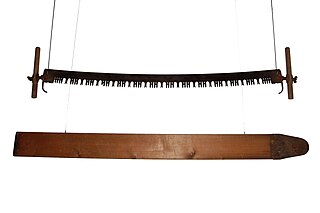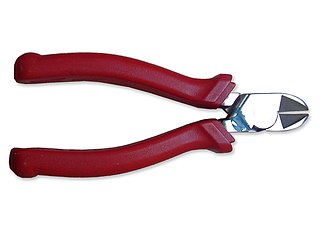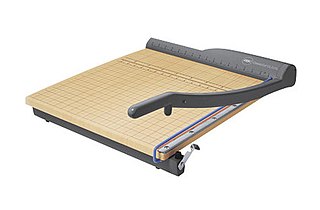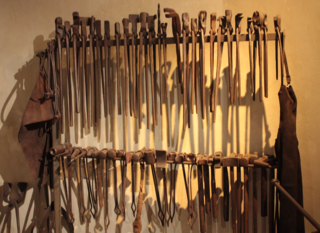
A utility knife is any type of knife used for general manual work purposes. Such knives were originally fixed-blade knives with durable cutting edges suitable for rough work such as cutting cordage, cutting/scraping hides, butchering animals, cleaning fish scales, reshaping timber, and other tasks. Craft knives are small utility knives used as precision-oriented tools for finer, more delicate tasks such as carving and papercutting.

The router is a power tool with a flat base and a rotating blade extending past the base. The spindle may be driven by an electric motor or by a pneumatic motor. It routs an area in hard material, such as wood or plastic. Routers are used most often in woodworking, especially cabinetry. They may be handheld or affixed to router tables. Some woodworkers consider the router one of the most versatile power tools.

Hydraulic rescue tools, also known as jaws of life, are used by emergency rescue personnel to assist in the extrication of victims involved in vehicle accidents, as well as other rescues in small spaces. These tools include cutters, spreaders, and rams. Such devices were first used in 1963 as a tool to free race car drivers from their vehicles after crashes.

Pliers are a hand tool used to hold objects firmly, possibly developed from tongs used to handle hot metal in Bronze Age Europe. They are also useful for bending and physically compressing a wide range of materials. Generally, pliers consist of a pair of metal first-class levers joined at a fulcrum positioned closer to one end of the levers, creating short jaws on one side of the fulcrum, and longer handles on the other side. This arrangement creates a mechanical advantage, allowing the force of the grip strength to be amplified and focused on an object with precision. The jaws can also be used to manipulate objects too small or unwieldy to be manipulated with the fingers.

A wire stripper is a small, hand-held device used to strip the electrical insulation from electric wires.

A crosscut saw is any saw designed for cutting wood perpendicular to (across) the wood grain. Crosscut saws may be small or large, with small teeth close together for fine work like woodworking or large for coarse work like log bucking, and can be a hand tool or power tool.

A miter saw or mitre saw is a saw used to make accurate crosscuts and miters in a workpiece by positioning a mounted blade onto a board. A miter saw in its earliest form was composed of a back saw in a miter box, but in modern implementation consists of a powered circular saw that can be positioned at a variety of angles and lowered onto a board positioned against a backstop called the fence.

A reciprocating saw is a type of handheld, small, machine-powered saw, in which the cutting action is achieved through a push-and-pull ("reciprocating") or back-and-forth motion of the blade. The original trade name, Sawzall, is often used in the United States, where Milwaukee Electric Tool first produced a tool of this type in 1951.

Diagonal pliers are pliers intended for the cutting of wire or small stock, rather than grabbing or turning. The plane defined by the cutting edges of the jaws intersects the joint rivet at an angle or "on a diagonal", giving pliers their name.

A paper cutter, also known as a paper guillotine or simply a guillotine, is a tool often found in offices and classrooms. It is designed to administer straight cuts to single sheets or large stacks of paper at once.
In the context of machining, a cutting tool or cutter is typically a hardened metal tool that is used to cut, shape, and remove material from a workpiece by means of machining tools as well as abrasive tools by way of shear deformation. The majority of these tools are designed exclusively for metals.

A hole saw, also known as a hole cutter, is a saw blade of annular (ring) shape, whose annular kerf creates a hole in the workpiece without having to cut up the core material. It is used in a drill. Hole saws typically have a pilot drill bit (arbor) at their center to keep the saw teeth from walking. The fact that a hole saw creates the hole without needing to cut up the core often makes it preferable to twist drills or spade drills for relatively large holes (especially those larger than 25 millimetres. The same hole can be made faster and using less power.

Porcelain tiles or ceramic tiles are either tiles made of porcelain, or relatively tough ceramic tiles made with a variety of materials and methods, that are suitable for use as floor tiles, or for walls. They have a low water absorption rate, generally less than 0.5 percent. The clay used to build porcelain tiles is generally denser than ceramic tiles. They can either be glazed or unglazed. Porcelain tiles are one type of vitrified tiles and are sometimes referred to as porcelain vitrified tiles.

A diamond tool is a cutting tool with diamond grains fixed on the functional parts of the tool via a bonding material or another method. As diamond is a superhard material, diamond tools have many advantages as compared with tools made with common abrasives such as corundum and silicon carbide.

A die grinder or rotary tool is a handheld power tool and multitool used for grinding, sanding, honing, polishing, or machining material. All such tools are conceptually similar, with no bright dividing line between die grinders and rotary tools, although the die grinder name tends to be used for pneumatically driven heavy-duty versions whereas the rotary tool name tends to be used for electric lighter-duty versions. Flexible shaft drive versions also exist.
Ceramic tile cutters are used to cut ceramic tiles to a required size or shape. They come in a number of different forms, from basic manual devices to complex attachments for power tools.

Pincers are a hand tool used in many situations where a mechanical advantage is required to pinch, cut or pull an object. Pincers are first-class levers, but differ from pliers in that the concentration of force is either to a point, or to an edge perpendicular to the length of the tool. This allows pincers to be brought close to a surface, which is often required when working with nails.

An oscillating multi-tool or oscillating saw is a multitool and power tool that oscillates, powered by battery or mains. The name "multi-tool" is a reference to the many functions that this tool can perform with the range of attachments available. "Master Tool" is also a trade name used in North America, short for the original tool by Fein called the Multi-Master. Attachments are available for sawing, sanding, rasping, grinding, scraping, cutting, and polishing.

A disc cutter is a specialised, often hand-held, power tool used for cutting hard materials, ceramic tile, metal, concrete, and stone for example. This tool is very similar to an angle grinder, chop saw, or even a die grinder, with the main difference being the cutting disc itself. This tool is highly efficient at cutting very hard materials, especially when compared to hand tools.

A jigsaw is a reciprocating saw that can cut irregular curves, such as stenciled designs, in wood, metal, or other materials.



















